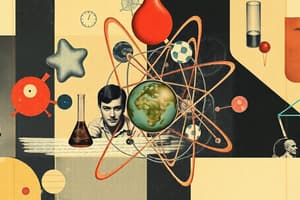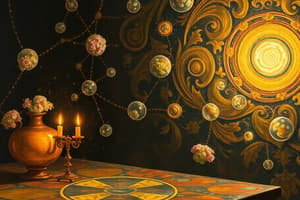Podcast
Questions and Answers
Which atomic model is characterized by a positively charged 'pudding' with negatively charged electrons dispersed throughout?
Which atomic model is characterized by a positively charged 'pudding' with negatively charged electrons dispersed throughout?
- Bohr-Rutherford Model
- Nuclear Model
- Plum Pudding Model (correct)
- Billiard Ball Model
According to Dalton's atomic theory, atoms are divisible.
According to Dalton's atomic theory, atoms are divisible.
False (B)
What particles contribute to the atomic mass of an atom?
What particles contribute to the atomic mass of an atom?
Protons and Neutrons
Ions formed by gaining electrons are called ________.
Ions formed by gaining electrons are called ________.
Match the scientist with their contribution to atomic theory:
Match the scientist with their contribution to atomic theory:
What is the maximum number of electrons that can occupy the first electron orbital?
What is the maximum number of electrons that can occupy the first electron orbital?
In a neutral atom, the number of protons is always equal to the number of neutrons.
In a neutral atom, the number of protons is always equal to the number of neutrons.
What type of bond is formed due to the sharing of electrons between atoms?
What type of bond is formed due to the sharing of electrons between atoms?
Elements in Group 1 of the periodic table tend to ________ electrons to achieve stability.
Elements in Group 1 of the periodic table tend to ________ electrons to achieve stability.
Which of the following properties is characteristic of ionic compounds?
Which of the following properties is characteristic of ionic compounds?
Molecular compounds are generally good conductors of electricity.
Molecular compounds are generally good conductors of electricity.
What is the name of the ionic compound formed between lithium and phosphorus?
What is the name of the ionic compound formed between lithium and phosphorus?
The prefix 'tri-' in a molecular compound indicates the presence of ________ atoms of that element.
The prefix 'tri-' in a molecular compound indicates the presence of ________ atoms of that element.
Which of the following is a diatomic element?
Which of the following is a diatomic element?
Match the following ions with their charges:
Match the following ions with their charges:
What is the formula for sulfur trioxide?
What is the formula for sulfur trioxide?
Elements in groups 6 and 7 have low electronegativity.
Elements in groups 6 and 7 have low electronegativity.
What is the name of the model proposed by Rutherford?
What is the name of the model proposed by Rutherford?
A positive ion is called a(n) ________.
A positive ion is called a(n) ________.
Which type of bond typically results in compounds with low melting points and poor conductivity?
Which type of bond typically results in compounds with low melting points and poor conductivity?
Flashcards
Dalton's Atomic Theory
Dalton's Atomic Theory
Atoms are indivisible, solid spheres.
Thomson's Atomic Model
Thomson's Atomic Model
Discovered the electron and proposed a model of positive charge with negative electrons embedded within.
Rutherford's Atomic Model
Rutherford's Atomic Model
Proposed a dense, positive nucleus with electrons surrounding it.
Bohr's Atomic Model
Bohr's Atomic Model
Signup and view all the flashcards
Protons
Protons
Signup and view all the flashcards
Neutrons
Neutrons
Signup and view all the flashcards
Electrons
Electrons
Signup and view all the flashcards
Atomic Mass
Atomic Mass
Signup and view all the flashcards
Neutral Atom
Neutral Atom
Signup and view all the flashcards
Ion
Ion
Signup and view all the flashcards
Cation
Cation
Signup and view all the flashcards
Anion
Anion
Signup and view all the flashcards
Ionic Bonds
Ionic Bonds
Signup and view all the flashcards
Covalent Bonds
Covalent Bonds
Signup and view all the flashcards
Naming Ionic Compounds
Naming Ionic Compounds
Signup and view all the flashcards
Naming Molecular Compounds
Naming Molecular Compounds
Signup and view all the flashcards
Diatomic Elements
Diatomic Elements
Signup and view all the flashcards
Study Notes
- Atoms consist of protons, neutrons, and electrons.
- Atomic mass is the sum of protons and neutrons.
Atomic Theory
- Dalton's atomic model described atoms as indivisible, solid spheres, known as the Billiard Ball Model.
- Thomson discovered the electron and proposed the Plum Pudding Model, where electrons are scattered in a positive charge.
- Rutherford discovered the dense, positive nucleus and created the Nuclear Model through the gold foil experiment.
- Bohr proposed that electrons orbit the nucleus in fixed energy levels, leading to the Bohr-Rutherford Model.
Atomic Structure Basics
- Protons carry a positive charge and reside in the nucleus.
- Neutrons have no charge and are located in the nucleus.
- Electrons have a negative charge and orbit the nucleus.
- The first orbital holds up to 2 electrons.
- The second orbital holds up to 8 electrons.
- The third orbital also holds up to 8 electrons for simpler atoms.
Neutral Atoms and Ions
- In a neutral atom, the number of protons equals the number of electrons, matching the atomic number.
- Ions are formed when atoms gain or lose electrons.
- A cation is a positive ion, such as Na⁺ (Sodium ion).
- An anion is a negative ion, like Cl⁻.
Periodic Table Trends
- Group 1 elements tend to donate electrons to achieve a stable outer shell.
- Group 6 and 7 elements are highly reactive and attract electrons strongly, exhibiting high electronegativity.
Chemical Bonding
- Ionic bonds form through electron transfer between atoms, typically between metals and non-metals.
- Ionic compounds have high melting points, are soluble in water, and conduct electricity in solution.
- Covalent bonds form through electron sharing between atoms, generally between non-metals.
- Covalent compounds have low melting points, poor conductivity, and are often insoluble in water.
Naming and Formulas
- For ionic compounds, name the metal first, followed by the non-metal with an "-ide" ending, charges must be balanced to write correct formulas.
- For molecular compounds, prefixes indicate the quantity of each element (mono-, di-, tri-, etc.) which is used to construct the formulas.
Prefixes for Molecular Compounds
- 1: Mono-
- 2: Di-
- 3: Tri-
- 4: Tetra-
- 5: Penta-
- 6: Hexa-
- 7: Hepta-
- 8: Octa-
- 9: Nona-
- 10: Deca-
Diatomic Elements
- The diatomic elements are H₂, N₂, O₂, F₂, Cl₂, Br₂, and I₂.
Studying That Suits You
Use AI to generate personalized quizzes and flashcards to suit your learning preferences.




